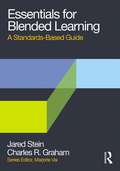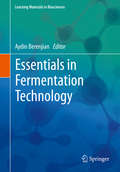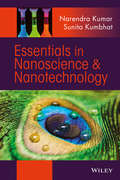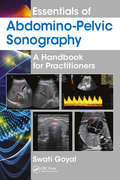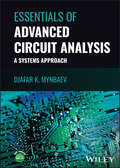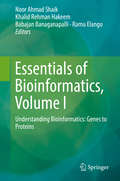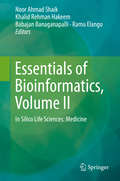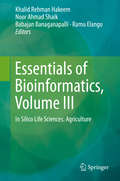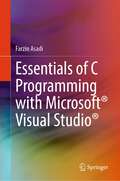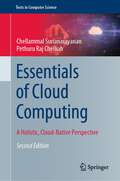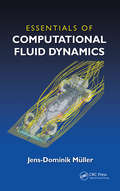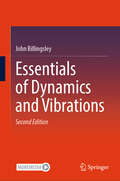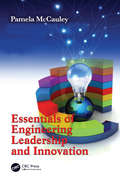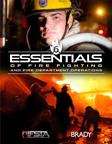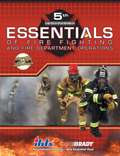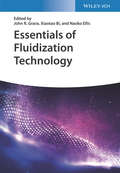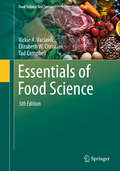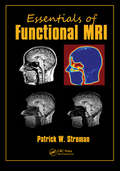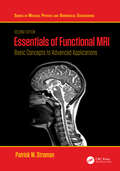- Table View
- List View
Essentials for Blended Learning: A Standards-Based Guide (Essentials of Online Learning)
by Charles R. Graham Jared SteinEssentials for Blended Learning: A Standards-Based Guide provides a practical, streamlined approach for creating effective learning experiences by blending online activities and the best of face-to-face teaching. This guide is: Easy to use: Clear, jargon-free writing; illustrations; and references to online resources help readers understand concepts. Streamlined: A simple but effective design process focuses on creating manageable activities for the right environment. Practical: Real-world examples from different subject areas help teachers understand principles in context. Contemporary: The variety of modern, connected technologies covered in the guide addresses a range of teaching challenges. Forward-Looking: The approach bridges the gap between formal classroom learning and informal lifelong learning. Standards-based: Guidelines and standards are based on current research in the field, relevant learning theories, and practitioner experiences. Effective blended learning requires significant rethinking of teaching practices and a fundamental redesign of course structure. Essentials for Blended Learning: A Standards-Based Guide simplifies these difficult challenges without neglecting important opportunities to transform teaching. This guide is suitable for teachers in any content area. Please visit www.essentialsforblended.com for additional resources.
Essentials in Fermentation Technology (Learning Materials in Biosciences)
by Aydin BerenjianThis textbook teaches the principles and applications of fermentation technology, bioreactors, bioprocess variables and their measurement, key product separation and purification techniques as well as bioprocess economics in an easy to understand way. The multidisciplinary science of fermentation applies scientific and engineering principles to living organisms or their useful components to produce products and services beneficial for our society. Successful exploitation of fermentation technology involves knowledge of microbiology and engineering. Thus the book serves as a must-have guide for undergraduates and graduate students interested in Biochemical Engineering and Microbial Biotechnology
Essentials in Nanoscience and Nanotechnology
by Narendra Kumar Sunita KumbhatThis book describes various aspects of nanoscience and nanotechnology. It begins with an introduction to nanoscience and nanotechnology and includes a historical prospective, nanotechnology working in nature, man -made nanomaterial and impact of nanotechnology illustrated with examples. It goes on to describes general synthetic approaches and strategies and also deals with the characterization of nanomaterial using modern tools and techniques to give basic understanding to those interested in learning this emerging area. It then deals with different kinds of nanomaterial such as inorganics, carbon based-, nanocomposites and self-assembled/supramolecular nano structures in terms of their varieties, synthesis, properties etc. In addition, it contains chapters devoted to unique properties with mathematical treatment wherever applicable and the novel applications dealing with information technology, pollution control (environment, water), energy, nanomedicine, healthcare, consumer goods etc.
Essentials of Abdomino-Pelvic Sonography: A Handbook for Practitioners
by Swati GoyalSonography has emerged as a substantial diagnostic tool today. This handbook aims to cover ultrasound physics, abdominal and obstetric sonography, color Doppler, high resolution sonography and USG guided interventions with multiple choice questions and case reports for practical orientation.
Essentials of Advanced Circuit Analysis: A Systems Approach
by Djafar K. MynbaevESSENTIALS OF ADVANCED CIRCUIT ANALYSIS Comprehensive textbook answering questions regarding the Advanced Circuit Analysis subject, including its theory, experiment, and role in modern and future technology Essentials of Advanced Circuit Analysis focuses on fundamentals with the balance of a systems theoretical approach and current technological issues. The book aims to achieve harmony between simplicity, engineering practicality, and perceptivity in the material presentation. Each chapter presents its material on various levels of technological and mathematical difficulty, broadening the potential readership and making the book suitable for both engineering and engineering technology curricula. Essentials of Advanced Circuit Analysis is an instrument that will introduce our readers to real-life engineering problems—why they crop up and how they are solved. The text explains the need for a specific task, shows the possible approaches to meeting the challenge, discusses the proper method to pursue, finds the solution to the problem, and reviews the solution's correctness, the options of its obtaining, and the limitations of the methods and the results. Essentials of Advanced Circuit Analysis covers sample topics such as: Traditional circuit analysis's methods and techniques, concentrating on the advanced circuit analysis in the time domain and frequency domain Application of differential equations for finding circuits’ transient responses in the time domain, and classical solution (integration) of circuit’s differential equation, including the use of the convolution integral Laplace and Fourier transforms as the main modern methods of advanced circuit analysis in the frequency domain Essentials of Advanced Circuit Analysis is an ideal textbook and can be assigned for electronics, signals and systems, control theory, and spectral analysis courses. It’s also valuable to industrial engineers who want to brush up on a specific advanced circuit analysis topic.
Essentials of Aquaculture Practices
by Muhammad Dawood Shah Norfazreena Mohd Faudzi Nurzafirah Mazlan Sitti Raehanah Muhamad ShalehAquaculture is expanding along with the increase in demand for animal protein and hence significantly contributes to food security and socioeconomic livelihood. This book gathers current principles of aquaculture that are applied and practiced globally. It covers crucial topics including site selection, breeding and husbandry techniques, nutrition, health management, biosecurity, and sustainability. Furthermore, aquaculture's impact on food production and the economic values generated by the industry are also explored. While emphasizing the significance of environmental sustainability, this book encourages practices that minimize negative impacts on the ecosystem and preserve the health of our oceans. As a collection of reviews on the current practices in aquaculture, this book is a resource for individuals working in or interested in the industry. It also serves as a reference and guideline for students, researchers, and aquaculture operators.
Essentials of Bioinformatics, Volume I: Understanding Bioinformatics: Genes to Proteins
by Khalid Rehman Hakeem Noor Ahmad Shaik Babajan Banaganapalli Ramu ElangoBioinformatics is an integrative field of computer science, genetics, genomics, proteomics, and statistics, which has undoubtedly revolutionized the study of biology and medicine in past decades. It mainly assists in modeling, predicting and interpreting large multidimensional biological data by utilizing advanced computational methods. Despite its enormous potential, bioinformatics is not widely integrated into the academic curriculum as most life science students and researchers are still not equipped with the necessary knowledge to take advantage of this powerful tool. Hence, the primary purpose of our book is to supplement this unmet need by providing an easily accessible platform for students and researchers starting their career in life sciences. This book aims to avoid sophisticated computational algorithms and programming. Instead, it mostly focuses on simple DIY analysis and interpretation of biological data with personal computers. Our belief is that once the beginners acquire these basic skillsets, they will be able to handle most of the bioinformatics tools for their research work and to better understand their experimental outcomes.Unlike other bioinformatics books which are mostly theoretical, this book provides practical examples for the readers on state-of-the-art open source tools to solve biological problems. Flow charts of experiments, graphical illustrations, and mock data are included for quick reference. Volume I is therefore an ideal companion for students and early stage professionals wishing to master this blooming field.
Essentials of Bioinformatics, Volume II: In Silico Life Sciences: Medicine
by Khalid Rehman Hakeem Noor Ahmad Shaik Babajan Banaganapalli Ramu ElangoBioinformatics is an integrative field of computer science, genetics, genomics, proteomics, and statistics, which has undoubtedly revolutionized the study of biology and medicine in past decades. It mainly assists in modeling, predicting and interpreting large multidimensional biological data by utilizing advanced computational methods. Despite its enormous potential, bioinformatics is not widely integrated into the academic curriculum as most life science students and researchers are still not equipped with the necessary knowledge to take advantage of this powerful tool. Hence, the primary purpose of our book is to supplement this unmet need by providing an easily accessible platform for students and researchers starting their career in life sciences. This book aims to avoid sophisticated computational algorithms and programming. Instead, it focuses on simple DIY analysis and interpretation of biological data with personal computers. Our belief is that once the beginners acquire these basic skillsets, they will be able to handle most of the bioinformatics tools for their research work and to better understand their experimental outcomes.Our second title of this volume set In Silico Life Sciences: Medicine provides hands-on experience in analyzing high throughput molecular data for the diagnosis, prognosis, and treatment of monogenic or polygenic human diseases. The key concepts in this volume include risk factor assessment, genetic tests and result interpretation, personalized medicine, and drug discovery. This volume is expected to train readers in both single and multi-dimensional biological analysis using open data sets, and provides a unique learning experience through clinical scenarios and case studies.
Essentials of Bioinformatics, Volume III: In Silico Life Sciences: Agriculture
by Khalid Rehman Hakeem Noor Ahmad Shaik Babajan Banaganapalli Ramu ElangoBioinformatics is an integrative field of computer science, genetics, genomics, proteomics, and statistics, which has undoubtedly revolutionized the study of biology and medicine in past decades. It mainly assists in modeling, predicting and interpreting large multidimensional biological data by utilizing advanced computational methods. Despite its enormous potential, bioinformatics is not widely integrated into the academic curriculum as most life science students and researchers are still not equipped with the necessary knowledge to take advantage of this powerful tool. Hence, the primary purpose of our book is to supplement this unmet need by providing an easily accessible platform for students and researchers starting their career in life sciences. This book aims to avoid sophisticated computational algorithms and programming. Instead, it will mostly focus on simple DIY analysis and interpretation of biological data with personal computers. Our belief is that once the beginners acquire these basic skillsets, they will be able to handle most of the bioinformatics tools for their research work and to better understand their experimental outcomes.The third volume is titled In Silico Life Sciences: Agriculture. It focuses on plant genetic, genomic, transcriptomic, proteomic and metabolomics data. Using examples of new crop diseases-emergence, crop productivity and biotic/abiotic stress tolerance, this book illustrates how bioinformatics can be an integral components of modern day plant science research.
Essentials of C Programming with Microsoft® Visual Studio®
by Farzin AsadiThis book provides a compact but comprehensive treatment that guides readers through the C programming language with Microsoft® Visual Studio®. The author uses his extensive classroom experience to guide readers toward deeper understanding of key concepts of the C language. Each concept and feature of the language is presented as a short lesson, illustrated by practical worked examples to aid student self study. The book will appeal to a broad range of students who are required to study the C programming language.
Essentials of Cloud Computing: A Holistic, Cloud-Native Perspective (Texts in Computer Science)
by Pethuru Raj Chelliah Chellammal SurianarayananNumerous advancements are being brought in and incorporated into the cloud domain with the aim of realizing a trove of deeper and decisive automations.Rather than discussing the cloud paradigm in isolation, this fully updated text examines how cloud computing can work collaboratively with other computing models to meet the needs of evolving trends.This multi-dimensional approach encompasses the challenges of fulfilling the storage requirements of big data, the use of the cloud as a remote server for Internet of Things and sensor networks, and an investigation of how cloud computing is interlinked with other established computing phenomenon such as edge computing. New chapters illustrate the distinct ideals of the cloud-native computing, proclaimed as the next-generation cloud computing paradigm.Topics and features:Includes learning objectives, motivating questions, and self-test exercisesIntroduces the underlying concepts, fundamental features, and key technological foundations of cloud computingExamines how enterprise networking and cloud networking can work together to achieve business goalsReviews the different types of cloud storage available to address the evolution of data and the need for digitizationDiscusses the challenges and approaches to implementing cloud governance, security, and the hot topic of cloud managementDescribes the details of cloud migration, the crucial role of monitoring in optimizing the cloud, and the basics of disaster recovery using cloud infrastructureThis technically rigorous, yet simple-to-follow textbook is an ideal resource for graduate courses on cloud computing. Professional software developers and cloud architects will also find the work to be an invaluable reference.
Essentials of Computational Fluid Dynamics
by Jens-Dominik MuellerCovered from the vantage point of a user of a commercial flow package, Essentials of Computational Fluid Dynamics provides the information needed to competently operate a commercial flow solver. This book provides a physical description of fluid flow, outlines the strengths and weaknesses of computational fluid dynamics (CFD), presents the basics o
Essentials of Control Techniques and Theory
by John BillingsleyCarefully separating the essential from the ornamental, Essentials of Control Techniques and Theory presents the nuts and bolts for designing a successful controller. It discusses the theory required to support the art of designing a working controller as well as the various aspects to convince a client, employer, or examiner of your expertise.A Compelling Account of the Basics of Control TheoryControl solutions for practicing engineersUsing the author’s own Javascript On-Line Learning Interactive Environment for Simulation (Jollies), the text relies on computer-based graphical analysis methods, such as Nyquist, Nichols, root locus, and phase-plane, to illustrate how useful computer simulation can be for analyzing both linear and nonlinear systems. It explains step-by-step the design and modeling of various control systems, including discrete time systems and an inverted pendulum. Along with offering many web-based simulations, the book shows how mathematics, such as vectors, matrices, and the differential equations that govern state variables, can help us understand the concepts that underpin the controller’s effects. From frequency domain analysis to time-domain state-space representation, this book covers many aspects of classical and modern control theory. It presents important methods for designing and analyzing linear systems and controllers.
Essentials of Digital Signal Processing
by B. P. Lathi Roger A. GreenThis textbook offers a fresh approach to digital signal processing (DSP) that combines heuristic reasoning and physical appreciation with sound mathematical methods to illuminate DSP concepts and practices. It uses metaphors, analogies and creative explanations, along with examples and exercises to provide deep and intuitive insights into DSP concepts. Practical DSP requires hybrid systems including both discrete- and continuous-time components. This book follows a holistic approach and presents discrete-time processing as a seamless continuation of continuous-time signals and systems, beginning with a review of continuous-time signals and systems, frequency response, and filtering. The synergistic combination of continuous-time and discrete-time perspectives leads to a deeper appreciation and understanding of DSP concepts and practices. • For upper-level undergraduates • Illustrates concepts with 500 high-quality figures, more than 170 fully worked examples, and hundreds of end-of-chapter problems, more than 150 drill exercises, including complete and detailed solutions • Seamlessly integrates MATLAB throughout the text to enhance learning
Essentials of Dynamics and Vibrations
by John BillingsleyThis updated second edition brings the complex mathematics of three-dimensional dynamics to life with real-time simulations, making the equations easier to grasp. Covering core topics in mechanical engineering such as kinematics, dynamics, vibration analysis, gyroscopes, gears, and Euler’s equations, the book offers a clear and engaging approach for students, professionals, and enthusiasts alike. With a focus on practical applications, it explains everything from the laws of motion to motors and mechanisms, providing a comprehensive understanding of mechanical systems. New to this edition is a chapter on Power, Energy, and Perpetual Motion, which reveals intriguing comparisons, such as the energy needed to lift water versus the heat required to warm it. The final chapter, Rocket Science, has been expanded to debunk myths about black holes and gravity, humorously addressing science fiction misconceptions while proposing exciting space projects.
Essentials of Engineering Leadership and Innovation (Systems Innovation Book Series)
by Pamela McCauleyThis book is a must-have resource for those engineering professionals seeking out best practice in engineering leadership and innovation. It is underpinned by years of applied experience in engineering settings, and is designed to develop and prepare engineers as leaders to accept the technical and managerial challenges that they will face as professionals At a time when engineering and innovation in technology is of importance on so many fronts, this text encourages engineers and technical professionals to become effective, socially conscious leaders and innovators. The text and course material is designed to create an environment of interactive, high-engagement learning that will produce lifelong skills. Some of the many benefits of this book include: Accompanying notes, instructor’s manual, sample syllabi for qualifying textbook adoption; A complementary website with a wealth of ancillary resources; Case studies in STEM contexts; An international approach, underpinned by years of experience in US settings; Practical advice on how to distinguish yourself as an engineering leader; A solid grounding in ethics and professional responsibility. Drawing together best practice in engineering leadership education, and current research in the field, this book is an essential read for those wishing to develop expertise in engineering leadership. Current professionals in the field, educators as well as students of engineering wishing to excel, will all be particularly interested readers.
Essentials of Fire Fighting (5th edition)
by Carl Goodson Lynne MurnaneThe 5th edition of Essentials of Fire Fighting offers bold new learning packages for students. There are several new components, all designed to add to the success of the student. In addition, established components have been improved.
Essentials of Fire Fighting and Fire Department Operations
by IfstaContinuing the tradition of excellence in firefighter education, this new, expanded version contains the complete 20 basic chapters, as well as additional chapters including first aid and hazardous materials response to meet all of the requirements for Fire Fighter I and II levels of NFPA 1001® and NFPA 472® and OSHA 1910. 120. This overhauled new edition offers a complete support package and includes updated information on 192 skill sheets, knot and rope requirements, the use of essential job tasks related to the medical requirements in NFPA 1582®, and more! Begin laying the foundation for your firefighting career now with this expanded version. View a Sample Chapter:http://info. ifsta. org/essentials-6th
Essentials of Fire Fighting and Fire Department Operations (5th Edition)
by Carl Goodson Lynne MurnaneThe Essentials of Fire Fighting and Fire Department Operations manual is intended to provide the firefighter candidate with the information needed to meet the fire-related performance objectives in NFPA 1001, Standard for Fire Fighter Professional Qualifications. The methods shown throughout the manual have been validated by the International Fire Service Training Association (IFSTA) as accepted methods for accomplishing each task.
Essentials of Fluidization Technology
by John R. Grace Xiaotao Bi Naoko EllisA concise and clear introduction to the basics of fluidization, with a view to its applications in the process and energy industries.
Essentials of Food Chemistry
by Jianquan Kan Kewei ChenThis book presents fundamental and practical information on food chemistry. Using 2-D barcodes, it illustrates the specific reactions and potential transformation mechanisms of food constituents during various manufacturing and storage processes, and each chapter features teaching activities, such as questions and answers, and discussions. Further, it describes various local practices and improvements in Asia. Divided into 12 chapters covering individual nutrients and components, including water, proteins, carbohydrates, lipids, vitamins, minerals, enzymes, pigments, flavoring substances, additives, and harmful constituents, it addresses their food chemistry, as well as their transformations during manufacturing processes, and typical or advanced treatments to improve food quality and safety. This book helps college students to gain a basic understanding of nutrients and food components, to discover and implement the practical industrial guidelines, and also to learn the latest developments in food chemistry.
Essentials of Food Science
by Vickie A. Vaclavik Elizabeth W. ChristianThe fourth edition of this classic text continues to use a multidisciplinary approach to expose the non-major food science student to the physical and chemical composition of foods. Additionally, food preparation and processing, food safety, food chemistry, and food technology applications are discussed in this single source of information. The book begins with an Introduction to Food Components, Quality and Water. Next, it addresses Carbohydrates in Food, Starches, Pectins and Gums. Grains: Cereals, Flour, Rice and Pasta, and Vegetables and Fruits follow. Proteins in Food, Meat, Poultry, Fish, and Dry Beans; Eggs and Egg Products, Milk and Milk Products as well as Fats and Oil Products, Food Emulsions and Foams are covered. Next, Sugar, Sweeteners, and Confections and a chapter on Baked Products Batters and Dough is presented. A new section entitled Aspects of Food Processing covers information on Food Preservation, Food Additives, and Food Packaging. Food Safety and Government Regulation of the Food Supply and Labeling are also discussed in this text. As appropriate, each chapter discusses the nutritive value and safety issues of the highlighted commodity. The USDA My Plate is utilized throughout the chapters. A Conclusion, Glossary and further References as well as Bibliography are included in each chapter. Appendices at the end of the book include a variety of current topics such as Biotechnology, Functional Foods, Nutraceuticals, Phytochemicals, Medical Foods, USDA Choosemyplate. gov, Food Label Health Claims, Research Chefs Association certification, Human Nutrigenomics and New Product Development.
Essentials of Food Science (Food Science Text Series)
by Vickie A. Vaclavik Elizabeth W. Christian Tad CampbellThe fifth edition of the Essential of Food Science text continues its approach of presenting the essential information of food chemistry, food technology, and food preparations while providing a single source of information for the non-major food science student. This latest edition includes new discussions of food quality and new presentations of information around biotechnology and genetically modified foods. Also new in this edition is a discussion of the Food Safety Modernization Act (FSMA), a comparison chart for Halal and Kosher foods and introductions to newly popular products like pea starchand the various plant-based meat analogues that are now available commercially and for household use. Each chapter ends with a glossary of terms, references, and a bibliography. The popular “Culinary Alert!” features are scattered throughout the text and provide suggestions for the reader to easily apply the information in the text to his or her cooking application. Appendices at the end of the book include a variety of current topics such as Processed Foods, Biotechnology, Genetically Modified Foods, Functional Foods, Nutraceuticals, Phytochemicals, Medical Foods, and a Brief History of Foods Guides including USDA Choosemyplate.gov. V.A. Vaclavik, Ph.D., RD. has taught classes in nutrition, food science and management and culinary arts for over 25 years at the college level in Dallas, Texas. She is a graduate of Cornell University, human nutrition and food; Purdue University, restaurant, hotel, institution management; and Texas Woman’s University, institution management and food science. Elizabeth Christian, Ph.D. has been an adjunct faculty member at Texas Woman’s University for more than 25 years, teaching both face-to-face and online classes in the Nutrition and Food Science department. She obtained her B.S. and her PhD. In Food Science from Leeds University, England, and then worked as a research scientist at the Hannah Dairy Research Institute in Scotland for Five years before moving to the United States. Tad Campbell, MCN, RDN, LD is a clinical instructor at The University of Texas Southwestern Medical Center at Dallas, where he teaches Food Science and Technology as well as other nutrition courses in the Master of Clinical Nutrition – Coordinated Program. He holds a Bachelor of Business Administration degree from Baylor University as well as a Master of Clinical Nutrition from UT Southwestern where he studied Food Science under Dr. Vickie Vaclavik.
Essentials of Functional MRI (Series in Medical Physics and Biomedical Engineering)
by Patrick W. StromanDuring the last two decades, new developments in functional MRI (magnetic resonance imaging) have made it possible to detect changes in the brain over time, as opposed to the "snapshot" produced by conventional MRI. Essentials of Functional MRI breaks down the technical challenges for physicians, researchers, and technologists who use functional MR
Essentials of Functional MRI: Basic Concepts to Advanced Applications (Series in Medical Physics and Biomedical Engineering)
by Patrick W. StromanEssentials of Functional MRI is explained from the basic theory underlying magnetic resonance imaging. This includes how it can be used to detect dynamic variations in neural activity to become “functional” MRI, and how fMRI can be used for a variety of applications. The reader will gain an understanding of how fMRI is currently used, its limitations, and how it is still developing. This is achieved by explaining the core concepts and building on them to explain how fMRI data are acquired and what physiological information they provide. These ideas are the key to understanding how the data are analyzed to detect physiological changes that are related to neural activity. With an understanding of the basic underlying concepts, the way that fMRI is used, and its limitations, are much easier to understand. This 2nd edition includes explanations of new advances in MRI techniques and fMRI data analysis methods, and updated examples of applications of fMRI, including current or future clinical applications. This book is intended for students, researchers, and clinicians, who want to understand the theory and practice of fMRI in sufficient detail to use it for neuroscience research, clinical research, and for clinical practice.
